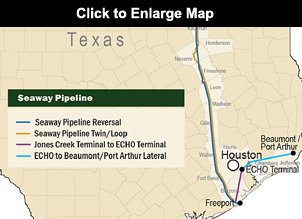About Seaway
 Download a PDF version of this map
Download a PDF version of this map.
Seaway Crude Pipeline Company LLC (Seaway) is a 50/50 joint venture between Enterprise Products Partners L.P., the operator, and Enbridge Inc., which purchased its ownership interest from ConocoPhillips on November 16, 2011. The Seaway system includes a 500-mile, 30-inch diameter pipeline between Cushing, Oklahoma and the Freeport, Texas area, and a terminal and distribution crude oil network originating in Texas City, Texas that serves all of the refineries in the Greater Houston area.
On May 17, 2012 Enterprise and Enbridge completed a project to reverse the flow direction of the Seaway Pipeline, allowing it to transport crude oil from the Cushing, Oklahoma hub to the vast refinery complex along the Gulf Coast near Houston. The first volumes arrived at the Jones Creek terminal, just north of Freeport, on June 6, 2012. In reversed service the line had an initial capacity of 150,000 barrels per day (BPD). Following pump station additions and modifications, which were completed in January 2013, the capacity of the reversed Seaway Pipeline increased to approximately 400,000 BPD of crude oil.
During a binding open commitment period held January 4, 2012 to February 10, 2012, shippers executed long-term, crude oil transportation agreements that provided the support necessary to move forward with construction of a loop (twin) of the Seaway Pipeline. The loop line parallels the existing right-of-way and was placed into service in July, 2014. Total aggregate capacity on the Seaway longhaul system is approximately 950,000 BPD, depending on the type and mix of crude oil being transported and other variables.
The Seaway reversal and expansion projects, have given shippers access to Enterprise's ECHO crude oil storage facility in southeast Houston and the Port Arthur/Beaumont refining complex.
Providing southbound capacity to the Gulf Coast from the Cushing hub facilitates the development of crude oil from growing North American basins, reduces the need for imported supplies and promotes domestic energy security. Expansion of the Seaway system and its ongoing operation has generated more than 3,000 jobs. Other benefits include increased use of local goods and services and additional tax revenue for the states and communities in which the infrastructure is located.